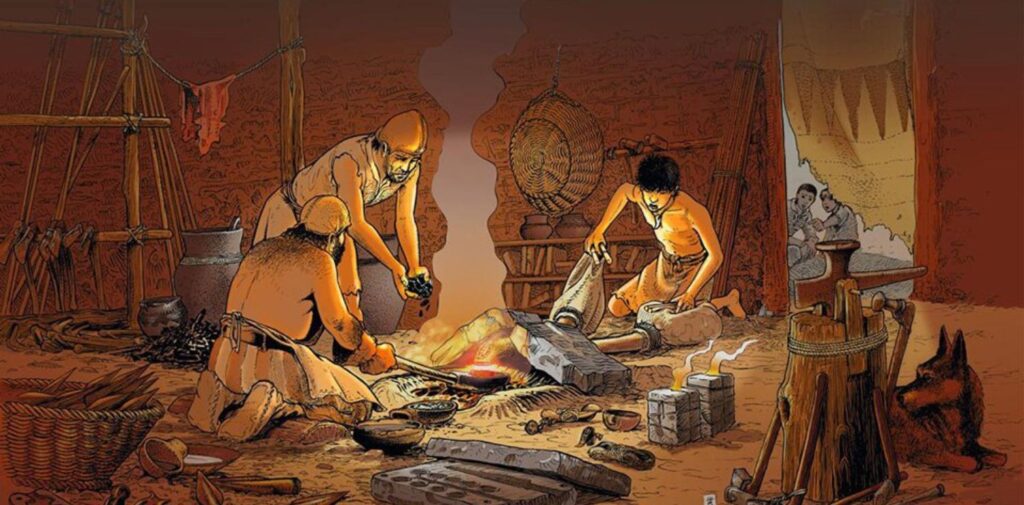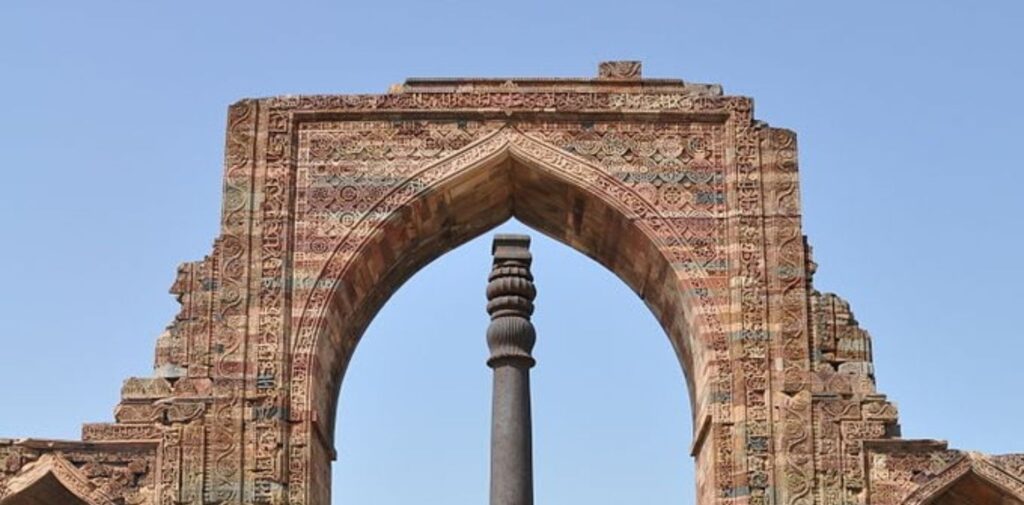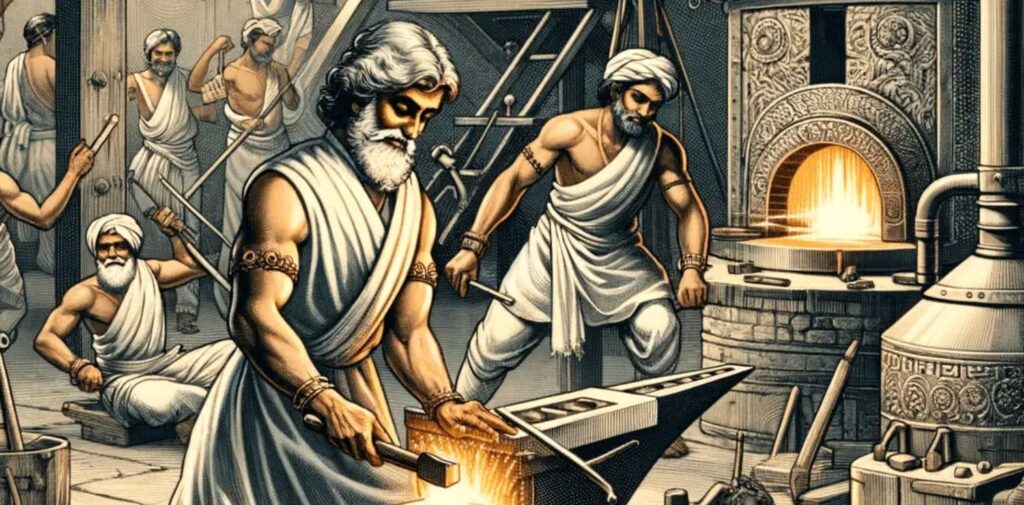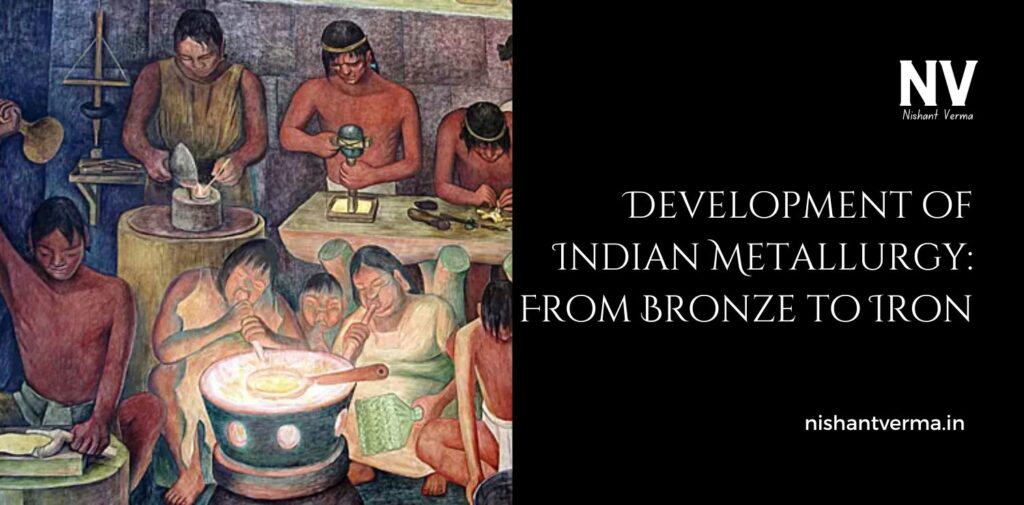Indian Metallurgy is the science of working with metals to make tools, weapons, and other useful objects. The development of metallurgy in India is a fascinating story of innovation, skill, and scientific progress that dates back thousands of years. From the early days of using simple copper and bronze to the discovery of iron, ancient Indian metallurgists made remarkable discoveries that shaped their civilization and the world. In this article, we will explore how Indian metallurgy evolved, from the use of bronze to the mastery of iron, and how it influenced the growth of ancient Indian society.
The Early Days: The Beginning of Metallurgy
The history of metallurgy in India goes back to the Indus Valley Civilization, which flourished around 3300 BCE to 1300 BCE. This ancient civilization, known for its well-planned cities like Mohenjo-Daro and Harappa, was one of the first in the world to use metals. However, during this period, the most common metal used was copper, not iron or bronze.
Copper is a metal that is found naturally in the earth. The people of the Indus Valley used copper to make tools, jewelry, and utensils. They learned how to heat copper to high temperatures, a process known as smelting, which allowed them to shape the metal into different objects.
As time passed, they began to mix copper with tin to make bronze, a stronger and more durable metal. This led to the development of the Bronze Age, which brought a huge advancement in technology and craftsmanship.

The Bronze Age: The Rise of Stronger Metals
During the Bronze Age, the use of bronze (a mix of copper and tin) spread across ancient India. Bronze was stronger than copper, which made it ideal for making weapons, tools, and even artistic sculptures. The famous Dholavira site in Gujarat, which was part of the Indus Valley Civilization, shows clear evidence of advanced bronze tools and artifacts.
Bronze was also used for making beautiful statues and coins. The most famous example of this is the Dancing Girl statue from Mohenjo-Daro, made from bronze. This small but detailed statue shows the high level of skill and creativity of ancient Indian metallurgists.
In addition to weapons and tools, bronze was also used in religious rituals and ceremonies. Vessels, bells, and idols made of bronze were common in the temples and homes of ancient India.
The Age of Iron: A New Discovery
While the use of copper and bronze was widespread in early Indian history, it was the discovery of iron that marked the beginning of a new chapter in Indian metallurgy. The transition from bronze to iron happened around 1200 BCE, during a time known as the Iron Age.
Iron is a much stronger and harder metal than bronze, and it quickly became the material of choice for making weapons, tools, and construction materials. The first signs of iron use in India have been found in places like Vidarbha in Maharashtra and the Ganga Valley.
The iron smelting process involved heating iron ore in a furnace until it became a solid mass of iron. This was a complicated process, and only skilled metallurgists could do it. Ancient Indian metallurgists learned to refine iron in such a way that they could create iron that was stronger and more durable than any metal that had come before.
Indian Iron: From Tools to Weapons
Iron changed the way people lived in ancient India. Iron tools like plows, axes, and sickles made farming easier and more efficient. This allowed farmers to grow more food and support larger populations. The improved farming tools also led to the development of more advanced irrigation systems, which helped make agriculture more productive.
Iron weapons such as swords, spears, and shields became important for defense and warfare. The use of iron gave ancient Indian kings and warriors a military advantage over their enemies. Iron was not just used for weapons; it was also used to make armor and fortifications, helping rulers protect their kingdoms from invaders.

The Iron Pillar of Delhi: A Marvel of Metallurgical Skill
One of the most remarkable achievements in Indian metallurgy is the Iron Pillar of Delhi, which was built during the Gupta period (around 400 CE). The Iron Pillar is a huge, 7-meter-tall structure made of nearly pure iron. What makes it special is that it has not rusted or corroded in over 1,600 years, despite being exposed to the weather.
This remarkable pillar shows just how advanced Indian metallurgists were in the art of working with iron. The fact that they were able to create such a durable and strong structure without the help of modern technology is a testament to their skill and knowledge.
The Use of Steel in Ancient India
In addition to iron, ancient Indian metallurgists also mastered the art of making steel, a stronger and more flexible form of iron. One of the most famous types of steel produced in India was known as Wootz steel. Wootz steel was made by heating iron with carbon and other elements, which made it harder and more flexible.
Wootz steel was highly valued not only in India but also in other parts of the world. It was used to make swords and weapons that were so strong and sharp that they were in high demand in places like Persia, Greece, and the Roman Empire. The ancient Indian steel industry played a key role in the global trade of high-quality steel.
The Influence of Indian Metallurgy on the World
Indian metallurgists not only advanced the use of iron and steel within India but also influenced the rest of the world. The technology of iron smelting spread from India to other parts of Asia, the Middle East, and Europe.
The famous Damascus steel, which was known for its sharpness and strength, is thought to have been influenced by the techniques developed by Indian metallurgists. Similarly, Indian Wootz steel became highly prized in ancient trade routes, and its influence can be seen in weapons and tools used across different parts of the world.

Indian Metallurgy in the Modern World
While India’s ancient metallurgists worked with simple tools and techniques, their discoveries laid the foundation for modern metallurgical practices. Today, India remains a major producer of iron, steel, and other metals, and its ancient techniques are still admired by engineers and metallurgists.
The Iron Pillar of Delhi continues to inspire awe among modern scientists, who study it to understand the techniques of ancient Indian metallurgy. Similarly, the art of making high-quality steel, once mastered in ancient India, continues to influence the steel industry worldwide.
Conclusion: The Legacy of Indian Metallurgy
The development of metallurgy in ancient India was a journey from simple copper tools to the mastery of iron and steel. Ancient Indian metallurgists invented new methods to work with metals, making tools, weapons, and sculptures that were both useful and beautiful. The discovery of iron revolutionized Indian society, leading to advances in agriculture, warfare, and construction.
Today, we continue to benefit from the discoveries made by ancient Indian metallurgists. From the Iron Pillar of Delhi to the steel used in modern buildings and machinery, the legacy of Indian metallurgy lives on, shaping our world in ways we might never fully understand.
Ancient Indian metallurgists were pioneers, and their contributions continue to inspire us as we explore new ways to work with metals in the modern world. Their skill, creativity, and scientific knowledge were truly ahead of their time.




